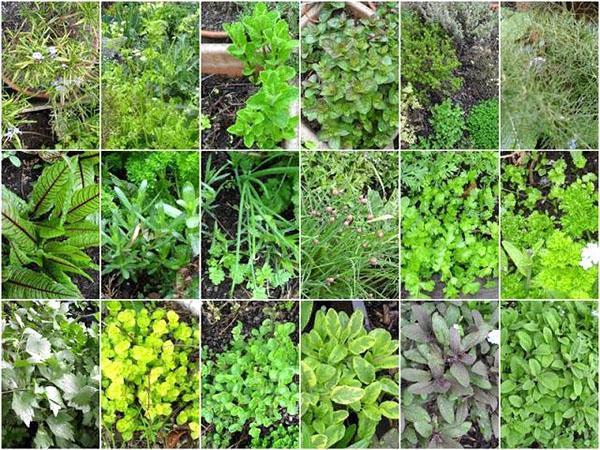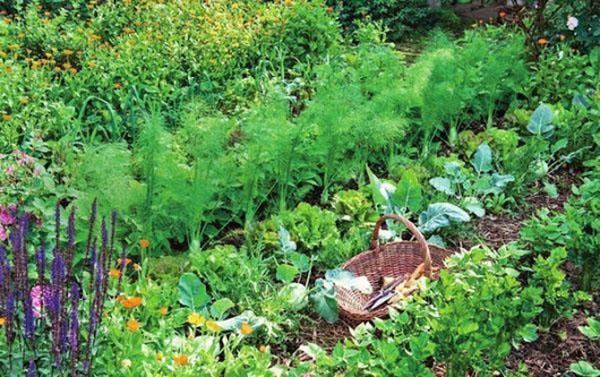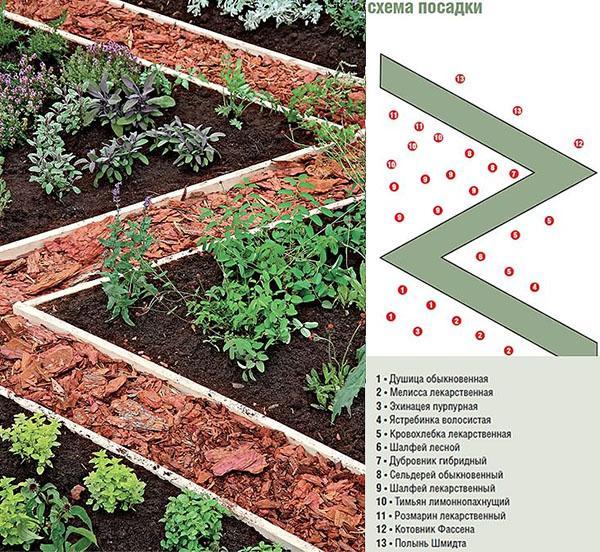Useful herbs in the garden - aromatic, tasty and medicinal
 Healthy herbs in the garden are not a know-how, but an ancient tradition. Today it is becoming fashionable to plant spices and medicinal crops on your site. Sunny places are selected for them. Then, under the influence of heat, a pleasant fragrance will emanate from the planting. Luxurious beds, borders or flower beds are created from such a spicy garden, which perfectly fit into the landscape interior. Now it's worth making out what to plant, where and how.
Healthy herbs in the garden are not a know-how, but an ancient tradition. Today it is becoming fashionable to plant spices and medicinal crops on your site. Sunny places are selected for them. Then, under the influence of heat, a pleasant fragrance will emanate from the planting. Luxurious beds, borders or flower beds are created from such a spicy garden, which perfectly fit into the landscape interior. Now it's worth making out what to plant, where and how.
In the summer cottage, such plants look great. Moreover, they emit a pleasant aroma, protecting the estate from pests and diseases. Moreover, they do not need special care.
Useful herbs in the garden - the ultimate in all dreams

- yarrow gives carrots a special sweetness;
- a smart chives border protects strawberries / flower crops from powdery mildew and gray rot;
- wormwood, nivyaniki and balsamic tansy improves the palatability of a number of growing fruits;
- the aroma of caraway scares away slugs, as well as snails;
- Pharmacy chamomile saturates parsnips, root parsley and carrots with essential oils.
Among other things, scented herbs attract many insects. And they, in turn, pollinate the entire plantation. It's no secret that this year many have faced a serious problem - heads of cabbage corn were half empty. But if there were herbs-spices in the garden, such excesses would not have happened. Nevertheless, the success of such an undertaking depends on good business organization.
It is recommended to constantly expand the selected collection of spices. At the same time, it is important to adhere to the crop rotation technology - change the planting site every 4 years.
Development of seeding schemes
 The first step is to choose a well-lit area. It should be free of drafts. Further, the shape of the future vegetable garden is determined:
The first step is to choose a well-lit area. It should be free of drafts. Further, the shape of the future vegetable garden is determined:
- triangle;
- square;
- a circle;
- zigzag;
- combined option.
 The plant varieties are now correctly distributed. The planting scheme for a herb garden is quite complex, since it often consists of several parts. The central front garden may look like this:
The plant varieties are now correctly distributed. The planting scheme for a herb garden is quite complex, since it often consists of several parts. The central front garden may look like this:
- In the middle are planted purple sage and blackheads. Make the form in the form of a yin-yang sign.
- Parsley and a number of pharmacy chamomile are brought to the fore.
- On the back (at the foot of the bench) rosemary and golden marjoram are placed, which will grow in the form of bushes.
- Separate the flower bed track from gravel.
A support for tall crops is built from rods or wire so that they do not obscure others. They adhere to a simple rule: small species are grouped around tall ones.
The walkway (on one side) is framed with a flower bed of lavender and bergamot. A source with water or a decorative bowl is installed in the corner. The second half of the flower bed is sown with calendula, as well as variegated lemon balm. The edging of such a masterpiece is a skorodin bow. Fragrant herbs will be in the background. It is better to arrange them in the following order:
- angelica;
- tansy;
- slope;
- fennel;
- digitalis.
A bold point in this row will be put by lungwort. The wall for such a company will be: planting of honeysuckle and marshmallow.
On the spice bed, there is a special place for annuals. It is recommended to sow it with dill, basil, deciduous mustard or chervil. The range of selected varieties largely depends on the tastes and preferences of the owners.
Options for creating an original flower bed
 In landscape design, extraordinary designs are often used. Experts successfully create amazing herb gardens right from the end of the house. They can have 3 execution variations:
In landscape design, extraordinary designs are often used. Experts successfully create amazing herb gardens right from the end of the house. They can have 3 execution variations:
- Island landings. Four round front gardens are arranged according to the rhombus principle. Sage is sown in the extreme corner, and basil and garlic in the neighboring ones. The last flower bed comes with mint, framed with thyme.
- In the form of a cross suit. Spicy herbs are sown only around the perimeter. The foreground consists of 2 varieties of basil (green and purple), followed by chives and leeks mixed with salad. Further along the row, tarragon, borago, sage, hot pepper and garlic are placed, and the last "petal" of the structure is taken away with curly mint.
- Miniature alpine slide. The central line includes savory, sage, basil and slug. There will be parsley in the front, and 2-3 varieties of onions (schmitt and slime) along with lemon balm in the back.
The given photo of spicy herbs with names shows the end result, because the plants are shown at the time of violent flowering. But these are just standard sketches. Therefore, the arrangement of crops can be changed depending on the wishes and goals of the gardener.
Some people practice immediately sowing seeds in open ground. Others advise using seedlings, because it makes it easier to see the final picture.
Difficult choice of crops
Now it is important to consider in more detail what spicy herbs can be grown in the garden to be beautiful and practical. A brief overview of each of them will help to determine the choice of suitable copies.
Mint
 Compact bushes emit a heady aroma, saturating the air with the freshness of menthol. These properties are possessed by 4 main varieties of mint:
Compact bushes emit a heady aroma, saturating the air with the freshness of menthol. These properties are possessed by 4 main varieties of mint:
- green curly;
- lemon (lemon balm);
- apple;
- peppery.
All of these varieties grow well both in shady and sunny areas. Loose, and most importantly, fertile land is suitable for culture. Water the greens twice a month. Otherwise, the water will not have time to dry, which will lead to stagnation.
The leaves of the fragrant plant are attached to the temples when the head hurts. For some, it helps even during migraine attacks.
Rosemary
 In appearance and smell, it resembles pine needles. Nevertheless, the aromatic twigs give the dishes a slight bitterness. In the garden, the spicy grass grows wonderfully if the soil is limestone. A place for it is selected without drafts and with sufficient lighting. The culture needs regular, but moderate watering. If you fill a garden bed, then the rhizome will simply fester. There are also 3 rules for successful care:
In appearance and smell, it resembles pine needles. Nevertheless, the aromatic twigs give the dishes a slight bitterness. In the garden, the spicy grass grows wonderfully if the soil is limestone. A place for it is selected without drafts and with sufficient lighting. The culture needs regular, but moderate watering. If you fill a garden bed, then the rhizome will simply fester. There are also 3 rules for successful care:
- in the spring to carry out shaping pruning;
- cover with dense material for the winter;
- every 7-8 years, cut the bush to nothing, as a rejuvenation.
It is necessary to collect and dry such perennial spicy herbs in the country at the beginning of summer, until they are old. In most cases, they are used as a seasoning, as well as for the creation of medical and cosmetic products.
Thyme
 The height of this half-shrub is 40 cm. Its branchy stem is either ascending or creeping. The harsh leaves have a rounded and sometimes oblong shape. Thyme has a wonderful lemon aroma and a bitter, pungent aftertaste. The shrub needs easy care:
The height of this half-shrub is 40 cm. Its branchy stem is either ascending or creeping. The harsh leaves have a rounded and sometimes oblong shape. Thyme has a wonderful lemon aroma and a bitter, pungent aftertaste. The shrub needs easy care:
- keep the soil moist, but not wet;
- avoid any shading;
- loosen the soil, which should not be acidic;
- in the spring, cut off the shoots to a stiff crust.
Traditionally, the foot is decorated with a fragrant plant alpine slides and rockeries. Fresh and dried leaves are used in vegetable soups and bean dishes, as well as in folk medicine.
Thyme spices up fatty fried meat.To enhance the aroma, it is added to baked goods: pies or pies. Such a useful herb is needed in the garden, since it is used for pickling cucumbers, tomatoes and zucchini, as well as smoking fish / meat.
Basil
 Many are faced with the fact that fragrant spice often does not arise. Therefore, the seasoning is recommended to be sown on seedlings 2 months before planting in the ground, that is, at the end of March. For this, containers are prepared with:
Many are faced with the fact that fragrant spice often does not arise. Therefore, the seasoning is recommended to be sown on seedlings 2 months before planting in the ground, that is, at the end of March. For this, containers are prepared with:
- garden land;
- humus;
- peat.
All components are taken equally. In early June, the seedlings are transferred to the site. The specimens are planted at a distance of 20 cm, leaving 30 cm for the aisle. Thanks to these parameters, the seedlings will have enough light and air so as not to become moldy.
After planting, the bed is covered with mulch and watered abundantly. At night, the basil is covered with foil so that it takes root safely.
Greens
 It is imperative to sow healthy greens in the garden. Of course, this collection includes the same top three:
It is imperative to sow healthy greens in the garden. Of course, this collection includes the same top three:
- dill;
- parsley;
- cilantro.
Nevertheless, they are always diluted with something new. Recently, arugula has won the audience's sympathy. However, for its successful cultivation, it is important to consider the following features:
- the temperature regime is from + 16 ° C, therefore, in early spring, the garden is covered;
- the acidity of the soil should be the lowest or neutral;
- touchdown depth 10-15 mm;
- row spacing up to 15 cm.
 Cut off the foliage when they have reached 10 cm. Arugula can be accompanied by one of the types of salad. Complement the composition with fennel, which is similar to dill. In one season, it can be sown 3 times.
Cut off the foliage when they have reached 10 cm. Arugula can be accompanied by one of the types of salad. Complement the composition with fennel, which is similar to dill. In one season, it can be sown 3 times.
The peculiarity of fennel is that both leaves with seeds and a false bulb are suitable for food. All parts of the plant give the dishes a pleasant sweetness.
Healing corner
Every caring housewife understands that it is simply impossible to do without medicinal herbs in the country (photos and names are given below). It is an invaluable contribution to family health and well-being. It is still important to choose the best varieties:
- Oregano is known as oregano. The herb is used to make tea or add it to meat dishes. It helps with coughs, skin diseases, gastrointestinal disorders and insomnia.

- Tarragon or tarragon. It gives a pleasant flavor to meat, fish, marinades and pickles. Useful for cardiovascular ailments.

- Mint and lemon balm. Enriches cold and hot drinks with an original aroma. It has a sedative, analgesic, perspiration and diuretic, and anti-inflammatory effect.

- Sage. Due to the antibacterial properties, infusions are used in the treatment of tonsillitis and diseases of the oral cavity. The culture has been growing for 8 years.

It should be borne in mind that some of the cultures mentioned are growing and eventually crowding out neighboring ones. Therefore, it is recommended to prune them on time.
Growing herbs in the garden does not require much effort, in addition to finding a sunny area for them that needs to be weeded and watered. Some plants will still need to be pruned, while others will even need to be covered and fed. At the same time, many people build a simple front garden or cover an ordinary wheel from a car with earth. However, the result is worth it, because healthy herbs in the garden are aromatic, tasty and medicinal.